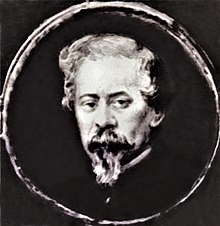Constantin Hormuzaki
Constantin Hormuzaki ( Romanian Hurmuzachi also Hurmuzaki ) (born November 12, 1811 in Chernivtsi (Cernăuți) ; † February 15, 1869 in Vienna , buried in Dulceşti , Neamț district ), was an Austrian lawyer and Romanian politician who was born and raised in the Duchy of Bukowina Minister.
origin
The family, which by their name is of Greek fanariotic descent, belonged to the Moldavian nobility. In 1636 a Hurmuzaki was presented with an estate by the Prince of Moldova because of his services to the royal council. During the reign of Prince Nikolaus Mavrocordatos , also a fanariot , Emanuel was head stable master and a member of the divan.
His grandfather Constantin Hurmuzaki († 1794), whose grandfather Grandpitar and whose father had been Grandpaharnik, bought the Cernăuca estate (German: Czernawka ) in what was then the Principality of Moldova (today in the Noua Suli Raă Raion ) in Ukraine . His son Doxaki went to southern Moldova as a young man, but returned to Bukovina (northern Moldova) in 1804 and the family now resided here permanently.
Constantin's father Doxaki (1782-1857) granted refuge to Romanian leaders from Transylvania, who had fled for political reasons, with great financial commitment. His brothers were the politicians Alexander and Eudoxius .
biography
As early as October 4, 1823, as a schoolboy, he wrote a political letter to Emperor Franz I. After graduating from high school in Czernowitz, he studied with his brother Eudoxius von Hormuzaki at the law faculty of the University of Vienna from 1830 to 1836 . He then worked mainly in Bessarabia, annexed by Russia in 1812 , in Chișinău , and in St. Petersburg . In 1840 he gained respect for the Moldovan Chancellor Grigore Lupu Balş's trials against the Russian state in St. Petersburg.
In 1848 he was co-editor of the newspaper Gazeta Bucovinei, which appeared in Romanian and German . Together with his brother, he campaigned for the autonomy of Bukovina as crown land within the Habsburg Monarchy.
Due to a dispute with his father over a love affair, he left Bukovina and moved to the Principality of Moldova.
In 1850 he became a member of the board of directors for the reorganization of public education, setting the general school rules. In 1852 he worked out a draft for a new criminal law. For this he was awarded the title Aga , a short time later he was given the position of head of the Princely Court ( Romanian: mare voric ). With the princely decree of April 1, 1856 he was formally naturalized. In the following years, Constantin campaigned strongly for the unification of the Romanian principalities, especially within the framework of the “Committee of Unification” (Comitetul Unirii).
After the unification of the principalities of Wallachia and Moldova under Prince Alexandru Ioan Cuza in 1859, the deputy became Minister of Justice (= Minister of Justice), and after the proclamation of the state of Romania, he became Romanian Minister of Justice with his seat in Iași (January 17, 1861).
Although he was seriously ill, he was appointed chairman of the court of cassation in Bucharest in the Kingdom of Romania in 1868 , an office he no longer really exercised because he went to Vienna for medical care, where he soon died.
In his honor, a street in Constanța and Sibiu bears his name.
literature
- Constantin Hormuzaki. In: Austrian Biographical Lexicon 1815–1950 (ÖBL). Volume 2, Verlag der Österreichischen Akademie der Wissenschaften, Vienna 1959, p. 421.
- Octav-George Lecca: Familiile boierești române. Istorie și genealogy. Bucureşti 2000, p. 339.
- Octav-George Lecca: Familiile boierești române. Seria 1. Genealogy a 100 de case. București 1911, tab. 47
- Erich Prokopowitsch: The nobility in Bukowina. Publishing house "Der Südostdeutsche", Munich 1983
- The travel diaries of the Austrian Emperor Franz I in Bukovina (1817 and 1823). Verlag "Der Südostdeutsche", Munich 1979, 89 pp.
- Kurt Scharr: "The Bukowina Landscape": The Becoming of a Region on the Periphery 1774–1918. Böhlauverlag GmbH and Co.KG, Vienna - Cologne - Weimar 2010
- IG Sbiera: Hurmuzachi. Enciclopedia Română, II., Bucharest 1900
- Ion Nistor: Istoria Bucovinei. Ed. Humanitas, Bucharest, 1991
Web links
Individual evidence
- ↑ Erich Prokopowitsch: The nobility in the Bukowina , publishing house "Der Südostdeutsche", Munich 1983, p. 124
- ^ IG Sbiera: "Hurmuzachi", Enciclopedia Română, (1900), II, pp. 736-739
- ↑ Rudolf Wagner (ed.): "The travel diaries of the Austrian Emperor Franz I in the Bukowina (1817 and 1823)", publishing house "Der Südostdeutsche", Munich 1979, p. 75a
- ↑ Luceac (Ed.), 2007, p. 12 f.
- ↑ Kurt Scharr: "The Bukowina Landscape": The Becoming of a Region on the Periphery 1774–1918, Böhlauverlag GmbH and Co. KG, Vienna - Cologne - Weimar 2010, p. 172 ff.
- ↑ a b Carmen Preotesoiu: "Patrioți cu inima, cu fapta", in "Jurnalul Național" of December 5, 2005
- ↑ Erich Prokopowitsch: The nobility in the Bukowina , publishing house "Der Südostdeutsche", Munich 1983, p. 163
- ↑ http://www.unitatimedicale.ro/category/view/5/page-3
- ↑ Sibiu.Net Coduri postale
| personal data | |
|---|---|
| SURNAME | Hormuzaki, Constantin |
| ALTERNATIVE NAMES | Hurmuzaki, Constantin; Constantin Hormuzaki (full name) |
| BRIEF DESCRIPTION | Austrian lawyer and Romanian politician |
| DATE OF BIRTH | November 12, 1811 |
| PLACE OF BIRTH | Chernivtsi |
| DATE OF DEATH | February 15, 1869 |
| Place of death | Vienna |


